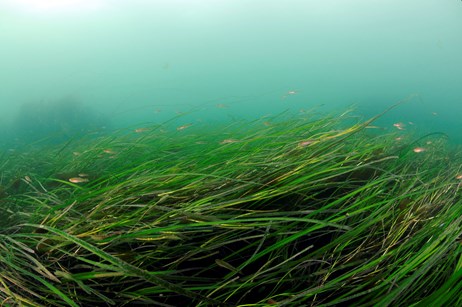Boosting Scotland's Coastline: A Focus On Seagrass Restoration

Table of Contents
The Ecological Importance of Seagrass in Scotland
Seagrass meadows are often called the "lungs of the sea," and for good reason. These underwater flowering plants play a vital role in the health of Scotland's marine environment. Their ecological importance is multifaceted:
-
Blue Carbon Powerhouse: Seagrass beds act as highly efficient carbon sinks, capturing and storing atmospheric carbon dioxide at a rate far exceeding that of terrestrial forests. This "blue carbon" sequestration is crucial in mitigating climate change. Scotland's seagrass meadows are a significant contributor to the nation's climate change mitigation efforts.
-
Biodiversity Hotspot: Seagrass meadows support an astonishing array of marine species. They provide essential habitats for juvenile fish, including commercially important species like cod and haddock, as well as crucial refuge for crustaceans, shellfish, and numerous invertebrates. Species like the edible seagrass snail and various seahorses depend entirely on these habitats.
-
Natural Coastal Defence: These resilient plants act as natural buffers, reducing coastal erosion by dissipating wave energy and stabilizing sediments. This natural protection safeguards our shorelines and the communities that depend on them.
Key Ecological Benefits in Bullet Points:
- Increased biodiversity (fish nurseries, shellfish habitats, supporting species such as seahorses and edible seagrass snails)
- Significant carbon sequestration (blue carbon)
- Robust coastal protection (erosion control, wave attenuation)
- Improved water quality (filtering pollutants)
Current Threats to Scotland's Seagrass Meadows
Despite their importance, Scotland's seagrass meadows are under severe pressure. Several factors contribute to their decline:
-
Pollution: Agricultural runoff containing fertilizers and pesticides, alongside untreated or inadequately treated sewage, introduces excessive nutrients and harmful chemicals into the marine environment, harming seagrass growth and health. This marine pollution Scotland is a significant threat.
-
Physical Damage: Boat anchors, dredging activities, and destructive fishing practices cause direct physical damage to seagrass beds, disrupting their delicate structure and hindering their ability to recover.
-
Climate Change: Rising sea temperatures, ocean acidification, and increased storm frequency linked to climate change place additional stress on seagrass meadows, weakening their resilience and making them more vulnerable to disease and other threats. The climate change impact on seagrass is a growing concern.
The consequence of seagrass loss is a domino effect, impacting the entire coastal ecosystem, reducing biodiversity, decreasing carbon sequestration, and increasing coastal vulnerability. This seagrass habitat loss necessitates urgent intervention.
Seagrass Restoration Techniques in Scotland
Fortunately, effective seagrass restoration techniques are being employed in Scotland. These include:
-
Seed Collection and Sowing: Seagrass seeds are collected and sown in carefully chosen areas, using techniques that mimic natural dispersal.
-
Transplanting of Seagrass Shoots: Healthy seagrass shoots are carefully transplanted to degraded areas, promoting regrowth and expansion of the meadows.
-
Habitat Restoration: Efforts focus on reducing pollution, mitigating physical damage from boat anchors (e.g., through mooring initiatives), and improving water quality. This habitat restoration techniques approach tackles the root causes of seagrass decline.
Scotland has seen both successes and challenges in seagrass restoration projects. Innovative techniques, such as the use of biodegradable mats to aid in transplantation, are constantly being developed and refined.
The Benefits of Seagrass Restoration for Scotland's Economy and Communities
Seagrass restoration offers significant economic and social benefits:
-
Sustainable Tourism: Healthy seagrass meadows support thriving marine ecosystems, attracting tourists and boosting the sustainable tourism Scotland sector.
-
Fisheries Support: Restored seagrass beds provide essential habitats for commercially important fish species, supporting sustainable fishing practices and enhancing the coastal economy.
-
Carbon Credits: The carbon sequestration capacity of seagrass meadows can generate revenue through carbon credit schemes, providing further incentives for restoration efforts.
Beyond economic benefits, seagrass restoration enhances the quality of life for coastal communities by improving water quality, protecting shorelines, and fostering a sense of pride and stewardship. The community engagement in these projects is crucial for long-term success.
Conclusion: Investing in the Future of Scotland's Coastline through Seagrass Restoration
Seagrass restoration is paramount for boosting Scotland's coastline. These vital ecosystems provide invaluable ecological, economic, and social benefits. The threats they face – pollution, physical damage, and climate change – necessitate urgent action. By investing in and supporting seagrass restoration, we safeguard biodiversity, enhance coastal protection, contribute to climate change mitigation, and secure a prosperous future for Scotland's coastal communities. We urge you to learn more about ongoing seagrass restoration projects in Scotland and consider supporting initiatives focused on seagrass restoration, coastal protection, and marine conservation. [Insert links to relevant organizations and initiatives here]. Investing in seagrass restoration in Scotland is an investment in a healthy, resilient, and thriving future for our nation's breathtaking coastline.

Featured Posts
-
 Childs Anxiety Causes Britains Got Talent Disruption
May 05, 2025
Childs Anxiety Causes Britains Got Talent Disruption
May 05, 2025 -
 2025 Kentucky Derby What Pace Will Determine The Winner
May 05, 2025
2025 Kentucky Derby What Pace Will Determine The Winner
May 05, 2025 -
 Kentucky Derby 2024 Final Preparations At Churchill Downs
May 05, 2025
Kentucky Derby 2024 Final Preparations At Churchill Downs
May 05, 2025 -
 Australia Election 2023 Voting Begins Labor Holds Lead
May 05, 2025
Australia Election 2023 Voting Begins Labor Holds Lead
May 05, 2025 -
 Russell Westbrooks Wife Nina A Look At Her Life And Career
May 05, 2025
Russell Westbrooks Wife Nina A Look At Her Life And Career
May 05, 2025
Latest Posts
-
 Colonial Downs Virginia Derby Stones Announcement And What It Means For Horse Racing
May 05, 2025
Colonial Downs Virginia Derby Stones Announcement And What It Means For Horse Racing
May 05, 2025 -
 Stones Announcement Key Details On The Upcoming Virginia Derby At Colonial Downs
May 05, 2025
Stones Announcement Key Details On The Upcoming Virginia Derby At Colonial Downs
May 05, 2025 -
 Virginia Derby Update Stones Announcement Signals Exciting Colonial Downs Meet
May 05, 2025
Virginia Derby Update Stones Announcement Signals Exciting Colonial Downs Meet
May 05, 2025 -
 Colonial Downs Prepares For Virginia Derby Stones Announcement Imminent
May 05, 2025
Colonial Downs Prepares For Virginia Derby Stones Announcement Imminent
May 05, 2025 -
 Stone To Announce Virginia Derby Meet At Colonial Downs A Major Racing Update
May 05, 2025
Stone To Announce Virginia Derby Meet At Colonial Downs A Major Racing Update
May 05, 2025
